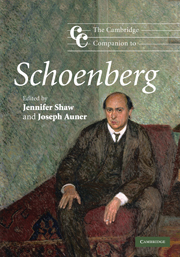Book contents
- Frontmatter
- 1 Introduction
- Part I Schoenberg's early years
- Part II Schoenberg, modernism, and modernity
- Part III Schoenberg between the World Wars
- Part IV Schoenberg's American years
- 15 Cadence after thirty-three years: Schoenberg's Second Chamber Symphony, Op. 38
- 16 Schoenberg's collaborations
- 17 Listening to Schoenberg's Piano Concerto
- 18 Schoenberg reception in America, 1933–51
- 19 Schoenberg: dead or alive? His reception among the postwar European avant-garde
- Notes
- Select bibliography
- Index
18 - Schoenberg reception in America, 1933–51
from Part IV - Schoenberg's American years
Published online by Cambridge University Press: 28 September 2011
- Frontmatter
- 1 Introduction
- Part I Schoenberg's early years
- Part II Schoenberg, modernism, and modernity
- Part III Schoenberg between the World Wars
- Part IV Schoenberg's American years
- 15 Cadence after thirty-three years: Schoenberg's Second Chamber Symphony, Op. 38
- 16 Schoenberg's collaborations
- 17 Listening to Schoenberg's Piano Concerto
- 18 Schoenberg reception in America, 1933–51
- 19 Schoenberg: dead or alive? His reception among the postwar European avant-garde
- Notes
- Select bibliography
- Index
Summary
Like countless refugees from Nazi Europe, Arnold Schoenberg spent an important part of his creative life in America (1933–51). Here he not only produced significant works, but also contributed greatly to America's musical culture. Yet, little research has been done on Schoenberg's American years and the reception of his work. Moreover, scholarly impressions of his American career tend to convey a variety of predominantly negative interpretations. Numerous Schoenberg commentators claim that he was an isolated figure, that his music was rarely performed and “could not fall on fertile ground,” and that his work was either misunderstood or ignored. In this chapter, I will challenge some of these perceptions and examine the question of American Schoenberg performances, along with aspects of the theoretical and compositional reception of his work in America.
Schoenberg performances and press reactions
The common view that Schoenberg's music was “practically not performed” in America is a myth inviting scrutiny. It partly grew out of Schoenberg's own worries about the dissemination of his music. He was troubled by the lean years of the Great Depression and World War II, when the arts saw major cutbacks, and was concerned about the conservatism predominating musical life in America. Yet his anxiety might have been prompted also by the feeling of what his fellow émigré Ernst Krenek called the “‘echolessness’ of the vast American expanses” – a notion implying that artists, for lack of feedback, were unaware of the full scope of their work's reception.
- Type
- Chapter
- Information
- The Cambridge Companion to Schoenberg , pp. 247 - 257Publisher: Cambridge University PressPrint publication year: 2010



